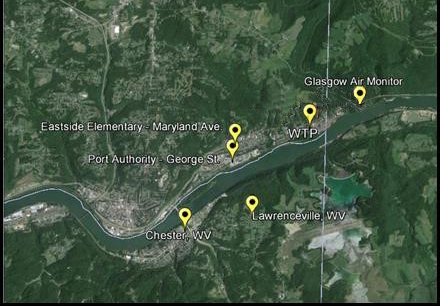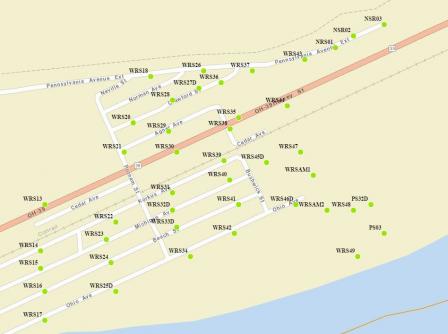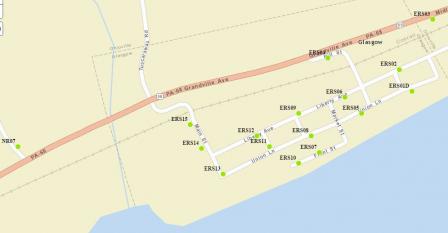East Liverpool, Ohio and Glasgow Borough, Pennsylvania– Air Monitoring Data 2/27/2018
- Settlement
- Introduction and Summary
- Soil Sampling
- Potential health effects of manganese
- About the monitoring
- Understanding the data
- About the data
- Air monitoring results charts and graphs
- Soil sampling locations
Settlement
The U.S. Environmental Protection Agency and the U.S. Department of Justice announced on January 18, 2017, a proposed consent decree with S.H. Bell Company requiring the company to monitor and take measures to reduce manganese emissions from its 92-acre plant that spans the Pennsylvania-Ohio border in Ohioville, Pa. and East Liverpool, Ohio.
This federal action builds upon actions previously taken by the Ohio Environmental Protection Agency and the Pennsylvania Department of Environmental Protection.
- Press Release: Settlement with S.H. Bell Requires Manganese Emission Safeguards at Plant in Ohioville, Pa. and East Liverpool, Ohio
- Consent Decree (PDF) (16 pp, 380 K, About PDF)
Introduction and Summary
Since 1999, U.S. Environmental Protection Agency, Ohio EPA and the federal Agency for Toxic Substances and Disease Registry (ATSDR) have monitored and analyzed the airborne levels of metals, including manganese (Mn) in East Liverpool, Ohio, at three monitoring stations. EPA has established this website as a means of providing the community with recent monitoring results and information concerning the airborne manganese levels.
Manganese is a naturally occurring element found in many soils, rocks and foods. While the element is an essential nutrient for living organisms, including humans, it is also necessary for the production of steel and is commonly found in industrial settings. Manganese can become toxic in humans at elevated exposure levels, leading to neurological and neuropsychological damage.
Data from 2006-2013 showed a downward trend of manganese concentrations recorded at the air monitors in East Liverpool. From 2014 - 2015 monitoring results showed an increase in manganese levels. This increase raised concerns at EPA, Ohio EPA, the Pennsylvania Department of Environmental Protection (PADEP) and ATSDR. The PADEP conducted additional air monitoring in Glasgow Borough, Pennsylvania from Oct. 26, 2014, to July 5, 2015. EPA officials also requested assistance from ATSDR to evaluate the potential health implications of the increased airborne manganese levels. ATSDR Letter Health Consultation (PDF) (13 pp, 1.4 MB, About PDF) (2016)
EPA is working with Ohio EPA and PADEP to reduce ambient manganese concentrations.
- Pennsylvania Health Department Letter Consultation for Glagow (PDF) (10 pp, 144 K, About PDF) Exit
- Fact Sheet: Health Study of Airborne Manganese Exposure in East Liverpool, Marietta and Mt. Vernon, Ohio (2013)
- Assessing Outdoor Air Near Schools: East Elementary School, East Liverpool, Ohio
- ATSDR Health Consultation for East Liverpool, Ohio Air Quality (PDF) (39 pp, 1.8 MB, About PDF) (2010)
Some of these reports were made publicly available shortly after their publication.
Soil Sampling
EPA conducted soil sampling in publicly owned areas of the East Liverpool and Glasgow communities the week of Oct. 17, 2016 due to concerns about elevated airborne manganese levels detected by air monitors in the area. These soil samples were analyzed for manganese and other metals. EPA reviewed the findings, compared the manganese levels to EPA’s Removal Management Level (RML) and ATSDR’s Comparison Value (CV) for manganese, and found that the reported manganese levels in the soil do not pose a health concern to the residents in the communities. This is also the case for iron and chromium levels. The evaluation considered several factors, including, but not limited to, the accessibility of the location, the frequency and duration of exposure, soil vegetative cover, and the population potentially exposed.
RMLs help identify areas, contaminants, and conditions where a removal action (for contamination posing an immediate threat to human health and the environment) may be appropriate. Sites where contaminant concentrations fall below RMLs, are not necessarily “clean,” and further action or study may be warranted under the Federal Superfund program. In addition, sites with contaminant concentrations above the RMLs may not necessarily warrant a removal action depending upon such factors as background concentrations, the use of site-specific exposure scenarios or other program considerations.
Information on RMLs and Removal Actions
Similarly, a CV is a dose or a calculated concentration of a substance in air, water, food, or soil that is unlikely to cause harmful (adverse) health effects in exposed people. ATSDR derives CVs from scientific studies which it modifies by safety factors to be more protective of human health, thus establishing the CV for a contaminant well below levels that are known or anticipated to result in adverse health effects.
ATSDR's Public Health Assessment Guidance Manual
The risk-based values derived by EPA and ATSDR for concentrations of manganese in residential soil are more protective of human health, and assume more frequent exposure to the contaminant than expected to occur at the sampled locations. Thus, an exceedance of these values at one or more locations does not necessarily indicate that EPA action is necessary to reduce exposure.
EPA’s RML for a residential exposure scenario:
- RML = 5,400 mg/kg of manganese
ATSDR CV for long-term (chronic) manganese exposure:
- Residential child exposure scenario = 2,900 mg/kg
- Residential adult exposure scenario = 40,000 mg/kg
Potential health effects of manganese
Humans require the mineral manganese in very small amounts to function normally. Most of our intake of manganese is from what we eat and drink. However, exposure to excess manganese can occur through inhalation of particulate matter containing manganese. Most of what we know about manganese as a neurotoxin, a substance that can damage the nervous system, comes from high levels of inhalation exposure in occupational and animal studies. Prolonged inhalation of airborne manganese can provoke a variety of serious toxic responses in humans, including impaired movement and effects on memory, judgment and reasoning. EPA conducted a recent study of the health impacts of manganese exposure in the East Liverpool community.
For more information about manganese exposure see ATSDR's Manganese Tox Profile (PDF)(555 pp, 10 MB, About PDF)
About the monitoring
 Ambient air monitoring locations in the vicinity of East Liverpool, Ohio.
Ambient air monitoring locations in the vicinity of East Liverpool, Ohio.
Beginning in 1999, ambient air monitors have measured manganese levels in East Liverpool by collecting 24-hour samples every sixth day at two monitoring stations on Maryland Ave. and at George St., and every third day at the monitoring station located at the Water Treatment Plant (WTP). The ambient air monitor in Glasgow, Penn. collected 24 hour samples every 6th day from Oct. 26, 2014 - July 25, 2015. Ambient air monitors in Chester and Lawrenceville, W. Va. collected 24 hour samples at least once a month. Ohio EPA, PADEP and West Virginia Department of Environmental Protection maintain their monitors, collect the samples, arrange for analysis and compile the results, which are then shared with U.S. EPA.
Understanding the data
ATSDR
In 2012, ATSDR evaluated available human and animal toxicity studies on manganese and derived a minimal risk level (MRL) for chronic manganese inhalation exposure of 0.3 µg/m3 (micrograms manganese per cubic meter).
EPA
In 1993, EPA’s Integrated Risk Information System (IRIS) evaluated available human and animal toxicity studies on manganese and derived a reference concentration (RfC) for chronic manganese inhalation exposure of 0.05 µg/m3. The 2015 IRIS Program Multi-Year Agenda listed manganese as having the highest priority for reassessment. This reassessment will determine if there is new information that could lead to a revised RfC.
- EPA Inhalation Reference Concentration for Manganese (PDF) (46 pp, 258 K, About PDF) (1993)
Significance of a Minimal Risk Level or Inhalation Reference Concentration
- Airborne concentrations of a pollutant that are below the MRL or RfC for a pollutant are unlikely to cause harmful health effects in humans.
-
Airborne concentrations that are greater than a MRL or RfC do not automatically mean there is a public health hazard caused by these emissions, but that further evaluation is needed.
About the data
The tables and figures below contain a summary of the manganese data collected at the air monitors in the vicinity of East Liverpool, Ohio. It is important to understand the difference between manganese levels measured as total suspended particulate (TSP) and manganese levels measured as respirable particulate. TSP is made up of respirable particles (small particles that can pass deep into the lung) and non-respirable particles (larger particles intercepted in upper airways before passing deep into the lung). MRL and RfC values are based on the respirable fraction of manganese-containing particulates (less than 10 microns in aerodynamic diameter i.e. PM10.)
Air monitoring results charts and graphs
| Monitoring Year | Annual Average TSP Mn Concentration (µg/m3) | TSP Mn Concentration Range (µg/m3)* |
|---|---|---|
| 2013 | 1.10 | 0.04 - 13.00 |
| 2014 | 1.48 | 0.03 - 32.00 |
| 2015 | 2.18 | 0.07 - 18.00 |
| 2016 | .91 | 0.03 - 11.00 |
| 2017 (Jan. - July) | .54 | 0.03 - 2.40 |
*The range represents individual readings taken every 3 days over the specified time period.
Table 2: Water Treatment Plant Monthly TSP Averages
| 2013 | 2014 | 2015 | 2016 | 2017 (Jan-July) | |
|---|---|---|---|---|---|
| January | 0.67 | 1.74 | 1.14 | 2.22 | .25 |
| February | 1.03 | 2.46 | 0.49 | 0.62 | 1.10 |
| March | 1.32 | 1.53 | 3.61 | 0.82 | 0.52 |
| April | 0.82 | 0.71 | 1.79 | 2.33 | 0.89 |
| May | 1.99 | 0.49 | 1.17 | 1.08 | 0.75 |
| June | 0.40 | 0.71 | 3.26 | 0.40 | 0.19 |
| July | 0.39 | 0.42 | 1.40 | 0.33 | 0.10 |
| August | 1.29 | 0.77 | 3.07 | .39 | |
| September | 0.75 | 5.99 | 1.51 | .66 | |
| October | 1.19 | 1.05 | 5.67 | .73 | |
| November | 2.05 | 0.76 | 1.24 | 1.07 | |
| December | 1.11 | 1.16 | 0.86 | .23 |
Table 3: Glasgow, PA TSP and Respirable Data from October 26, 2014 - July 5, 2015
| Monitoring Data | Average Air-Mn Concentration (µg/m3) | Peak Air-Mn Concentration (µg/m3) |
|---|---|---|
| TSP | 0.5210 | 2.23 |
| Respirable | 0.145 | 0.861 |
Figure 1: Monthly TSP Averages of Mn Monitoring Results in Glasgow
Figure 2: Annual TSP Averages of Mn Monitoring Results at All Monitors 2009-2016
Glasgow’s air monitoring data was unable to be included in the chart above because an annual average could not be calculated using the 9 months of data collected.
Table 4: Water Treatment Plant Monthly PM10 Averages
| 2009 | 2011 | 2012 | 2013 | 2014 | 2015 | 2016 | 2017 (Jan-Jul) |
|
|---|---|---|---|---|---|---|---|---|
| January | 0.03 | 0.07 | 0.06 | 0.45 | 0.08 | 0.36 | 0.07 | |
| February | 0.34 | 0.16 | 0.17 | 0.21 | 0.08 | 0.09 | 0.13 | |
| March | 0.14 | 0.05 | 0.30 | 0.16 | 0.41 | 0.09 | 0.06 | |
| April | 0.20 | 0.06 | 0.24 | 0.07 | 0.32 | 0.19 | 0.33 | |
| May | 0.05 | 0.06 | 0.11 | 0.06 | 0.18 | 0.21 | 0.12 | |
| June | 0.03 | 0.01 | 0.04 | 0.05 | 0.10 | 0.42 | 0.05 | 0.02 |
| July | 0.07 | 0.40 | 0.13 | 0.03 | 0.05 | 0.38 | 0.04 | 0.04 |
| August | 0.14 | 0.52 | 0.10 | 0.09 | 0.07 | 0.62 | 0.11 | |
| September | 0.60 | 0.51 | 0.30 | 0.05 | 0.91 | 0.34 | 0.09 | |
| October | 0.31 | 0.13 | 0.08 | 0.24 | 1.38 | 0.04 | ||
| November | 0.03 | 0.04 | 0.09 | 0.03 | 0.25 | 0.19 | ||
| December | 0.40 | 0.14 | 0.17 | 0.10 | 0.15 | 0.05 |
Table 5: Water Treatment Plant Annual PM10 Averages and Range
| Monitoring Year | Annual Average PM10 Manganese Concentration (µg/m3) | PM10 Manganese Concentration Range (µg/m3)* |
|---|---|---|
| 2009 | 0.16 | 0.01 - 1.10 |
| 2011 | 0.22 | 0.00 - 2.45 |
| 2012 | 0.11 | 0.01 - 1.40 |
| 2013 | 0.12 | 0.01 - 1.00 |
| 2014 | 0.21 | 0.01 - 3.60 |
| 2015 | 0.39 | 0.02 - 3.40 |
| 2016 | 0.14 | 0.02 - 1.10 |
| 2017 (Jan-July) | 0.11 | 0.01 - 0.71 |
*The range represents individual readings taken every 6 days over the specified time period.
Water Treatment Plant, East Liverpool, Ohio, Manganese PM10 Concentrations Data (2009, 2011-2016)
Soil Sampling Locations
 East Liverpool, Ohio Soil Sampling Locations
East Liverpool, Ohio Soil Sampling Locations
 East Liverpool, Ohio Soil Sampling Locations
East Liverpool, Ohio Soil Sampling Locations



